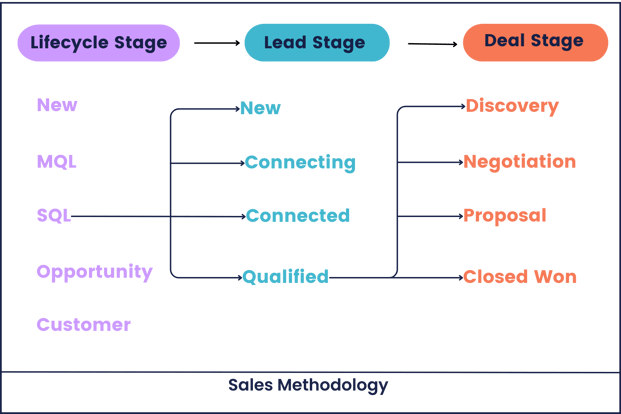HubSpot lifecycle stages best practices - how to leverage them to boost revenue momentum
Ah, the eternal struggle between marketing and sales, a narrative as old as business itself. Picture this: marketing teams generate leads, nurturing them until they're ripe for the picking. Then they toss these leads over to the sales department, fingers crossed, hoping they'll work their magic. More often than not, chaos ensues. Sales complains the leads are unripe, unqualified, or simply vanish into thin air. It's a classic case of miscommunication, a tale of two teams at odds, each with its own agenda and frustrations.
Enter lifecycle stages for the HubSpot CRM platform – the unsung heroes in the battle for marketing and sales alignment. These stages are the breadcrumbs that guide your leads along the path from initial contact to delighted customer. Used effectively they also pilot a harmonious journey for marketing and sales through the funnel.
The HubSpot lifecycle stage model is a classic funnel model of lead movement. Leads enter the top of the funnel as subscribers, gradually progressing through stages. From leads to MQLs (marketing qualified leads), from SQLs (sales qualified leads) to opportunities, and finally, to cherished customers and enthusiastic evangelists – each stage represents a milestone in the buyer's journey. And through it all, HubSpot lifecycle stages light the path forward for your entire team, from sales to success.
Why lifecycle stages work is that they provide your whole business, including marketing and sales, a common language for understanding how customers find, buy and succeed with your products. You can better coordinate your activities on guiding them on this journey, and you can measure it in a consistent manner.
Let's take a closer look at HubSpot lifecycle stages and how to leverage them to boost your revenue.
Seven best practices for optimising your B2B HubSpot lifecycle stages
When you've been around HubSpot for as long as Concentrate have, you get a clear idea of what works best when it comes to getting your lifecycle stages working effectively. Here's how to get your HubSpot lifecycle stages optimised for maximum momentum.
- Sync company and contact stages
For B2B organisations, it's often more beneficial to define lifecycle stages at the company level rather than the contact level, so make sure they’re synced in HubSpot. It's only a tweak but it can work wonders for your marketing and sales harmony. - Tailor definitions to fit your business
Craft lifecycle stage definitions that resonate with your unique business processes and team dynamics. From subscribers to evangelists, each stage should be tuned to reflect your customer journey's nuances. Here's what our starting definition looks like:
-1.png?width=598&height=716&name=Concentrate%20Blog%20Table%20MAR24%20(1)-1.png)
- Move forward, not back
Lifecycle stages are like checkpoints on a one-way street – they don't backtrack. When resetting stages due to churned customers or lost deals, employ workflows to first clear the stage before resetting it, ensuring a smooth transition forward. - Automate lifecycle stages with data triggers
Manually maintaining lifecycles quickly becomes old when you have any sort of volume. Outline clear data triggers that automatically propel companies through lifecycle stages based on key signals within your HubSpot platform. Whether it's scoring thresholds for MQLs or deal wins for customers, automation streamlines the process with precision. - Streamline lifecycle stage changes across workflows
To prevent the dreaded tangled web of conflicting rules and dependencies, it's essential to centralise lifecycle stage changes in a few strategic places, such as workflows. By doing so, you maintain consistency and prevent chaos that arises from multiple conflicting rules or dependencies scattered throughout your system. This approach ensures that all lifecycle stage changes are managed efficiently and consistently, reducing the risk of errors and confusion. With clear and defined workflows governing lifecycle stage changes, you can avoid the pitfalls of tangled rules and dependencies, allowing for smoother operations and more reliable data management. - Track lifecycle stage dates
Time is of the essence. Make sure you're keeping tabs on individual lifecycle stage dates i.e. marking the times when a company transitions from one stage to another. This tracking ensures accurate funnel reporting and actionable insights into your customer journey's progress. - No skipping allowed
Stay on track with automation safeguards. Prevent companies from leapfrogging lifecycle stages with robust automation measures. This is particularly crucial for tracking conversion rates accurately, making sure that every step of the journey is accounted for.
What is the difference between HubSpot lifecycle stages, HubSpot lead status and HubSpot deal stages?
In HubSpot, lifecycle stages, lead status, and deal stages serve distinct yet complementary purposes for optimising your sales process:
- HubSpot lifecycle stage - a holistic view of how contacts progress through their entire lifecycle journey with your organisation. It encompasses all forward movements, from creation to deletion, offering a comprehensive classification of your entire database.
- HubSpot lead stage - tracks the specific actions sales take when a contact is in the Sales Qualified Lead (SQL) lifecycle stage. While there are default options in HubSpot, you can customise these based on your process.
- HubSpot deal stage - delineates a prospect's journey from deal creation to decision-making, aligning with the sales process of your company. It specifically focuses on current opportunities in your deal pipeline, enabling effective tracking of their progress.
While Lifecycle Stages provide a broad overview of your database journey, lead status zooms in on sales efforts for specific qualified leads, and deal stages streamline the tracking of individual opportunities through the sales process. Each serves a unique role in optimising sales efficiency and performance metrics. Here's a good visual representation:

Funnelling fun - tracking conversions in HubSpot
How do you know if you're getting it right? This is where conversion funnel reporting comes in. They're a trusty GPS for navigating the twists and turns of your sales journey. Think of them as giving you an elevated view of the whole journey, where it is progressing well and where there are bottlenecks.
They help you analyse conversion rates, revealing how leads progress through your sales pipeline over any given timeframe. You can set your own benchmarks and compare them to industry best practice e.g. the percentage of leads converting to MQLs, or SQLs to opportunities.
But why stop there? Conversion funnel reports can also help propel your RevOps strategy. By dissecting the data, you can uncover hidden gems and revenue opportunities lurking within your pipeline. For instance, if you notice that deals are languishing in the pipeline for an eternity, with an average of 50 days spent in limbo, it's a clear sign that there's room for improvement. Armed with this knowledge, you can rally the troops and set your sights on reducing that time-to-close metric, one sprint at a time.
And let's not forget about the power of conversion rates. A mere percentage point increase may seem insignificant at first glance, but when you zoom out and crunch the numbers, it's like adding fuel to your revenue rocket. A bump from 5% to 6% might not sound like much, but it could translate to a few extra sales — a game-changer in the world of revenue optimisation.
Start mastering your HubSpot lifecycle stages
From defining your stages to automating workflows and tracking conversions, every step counts on the journey to revenue success.
By following these best practices, you'll not only streamline your sales process but you'll better align your marketing and sales teams. With clear definitions and automated workflows in place, you'll eliminate the guesswork and ensure that every lead moves smoothly through your pipeline.
Whether you're fine-tuning your lead management strategy or embarking on a quest for revenue optimisation, remember: HubSpot lifecycle stages are a secret weapon for driving growth and accelerating your path to success. With the right strategy and a sprinkle of RevOps magic, you'll be well on your way to genuine sales success.
Keen to learn more about how to leverage HubSpot lifecycle stages? Book a discovery meeting with us and we'll get started.
Share this
You May Also Like
These Related Stories
-1%20(1).jpg?width=5500&height=4000&name=Concentrate%20-%20Blog%20Hero%20Images%20(3)-1%20(1).jpg)
'RevUp' your HubSpot
.jpg?width=2048&height=1076&name=A7400060%20(1).jpg)
HubSpot July 2024 Updates: Concentrate’s Favourite New Features
